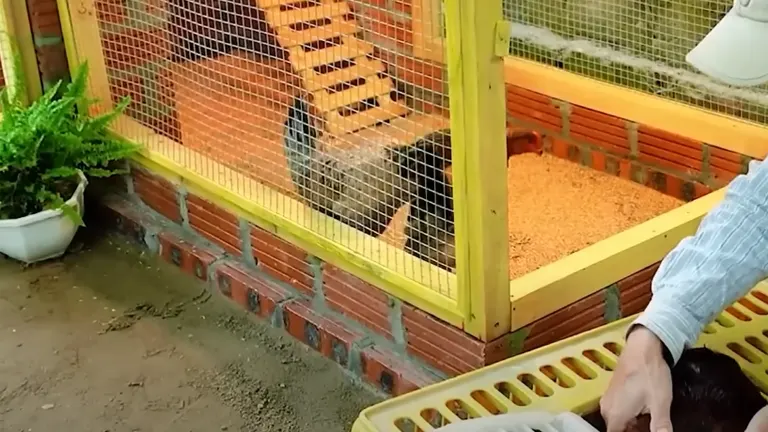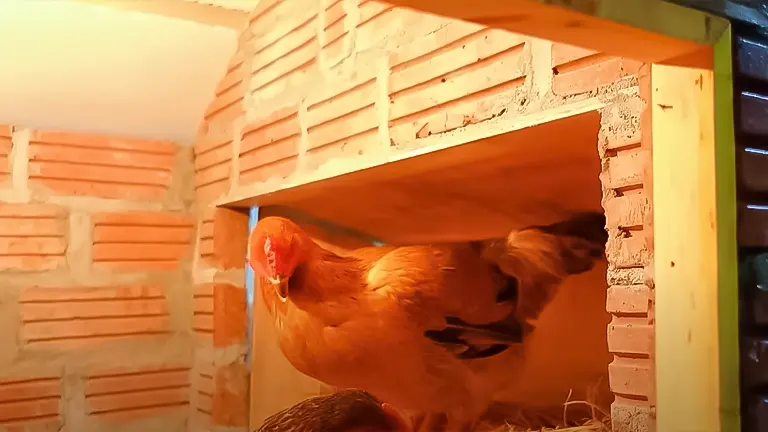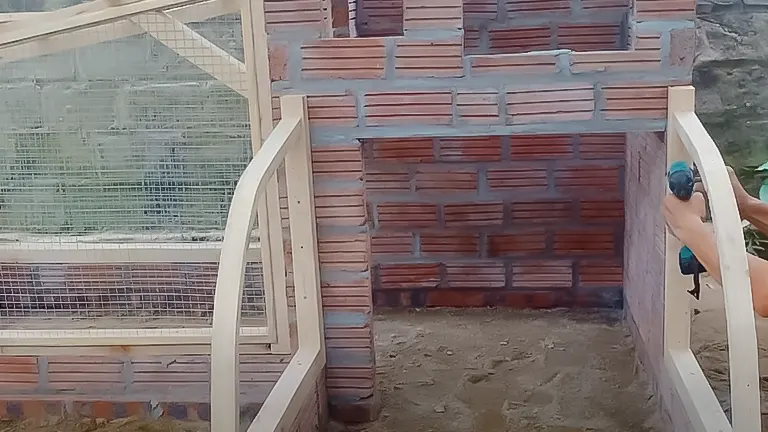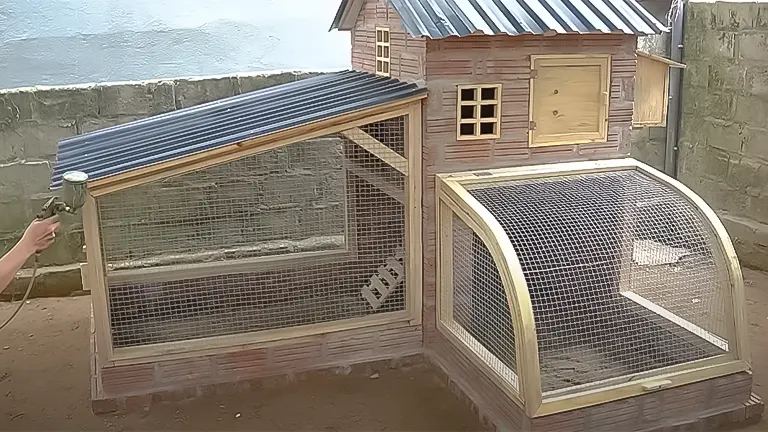How to Easily Build a Low-Budget Chicken Coop
- March 28, 2024
- 0 comment
Discover how to easily build a low-budget chicken coop, utilizing creativity, fundamental DIY abilities, and careful planning to ensure a secure and cozy habitat for your chickens without excessive spending.

This guide offers a step-by-step approach to constructing a cost-effective chicken coop, complete with expert tips and recommendations. Whether you’re a seasoned farmer or a new backyard poultry keeper, this article will help you navigate the process with ease and confidence.
List on How to Easily Build a Low-Budget Chicken Coop:
- Planning and Designing Your Chicken Coop
- Sourcing Affordable Materials
- Building the Foundation and Frame
- Adding Walls, Doors, and Windows
- Roofing and Weatherproofing
- Interior Setup and Predator Protection
Understanding The Basics To Build Chicken Coop With Your Low Budget
Understanding the basics of building a chicken coop with a low budget is crucial for anyone looking to provide a safe and comfortable home for their chickens without overspending. This endeavor combines practicality with creativity, allowing you to construct a functional coop tailored to your needs and constraints. Here’s what you need to know to embark on this rewarding project:

- Determine Your Needs: Before diving into construction, assess how many chickens you plan to keep, as this will dictate the size and type of coop you need. Consider the space available in your backyard and local climate conditions, which will influence your design choices, such as insulation and ventilation.
- Design Wisely: A well-thought-out design is key to building an efficient and low-cost chicken coop. Utilize free online resources or library books for coop designs. Your design should prioritize easy access for cleaning, efficient air circulation, and protection from predators. Remember, a simple design is not only cost-effective but also easier to build and maintain.
- Source Materials Economically: The bulk of your savings will come from how you source your materials. Look for recycled or second-hand materials from local ads, community boards, or construction sites. Pallets, reclaimed wood, and leftover construction materials can often be obtained for free or at a low cost. However, ensure that these materials are safe and free from hazardous chemicals.
- DIY as Much as Possible: Labor can significantly increase the cost of any project. By doing the work yourself, you can save on these expenses. There are plenty of tutorials and guides available that cater to different skill levels. Borrow tools from friends or neighbors to reduce costs further.
- Prioritize Function Over Aesthetics: While it’s tempting to build an aesthetically pleasing coop, functionality should come first, especially with a tight budget. Ensure your coop has adequate space for roosting, nesting boxes, and is secure from predators. Cosmetic enhancements can always be added later as your budget allows.
- Security Is Paramount: Don’t cut corners when it comes to securing your coop from predators. Use hardware cloth instead of chicken wire for enclosures, as it’s more durable against predators like raccoons and foxes. Ensure doors and openings are secure to keep your chickens safe.
- Ventilation and Insulation: Proper ventilation is crucial to keep the air inside the coop fresh and to prevent moisture buildup, which can lead to health issues for your chickens. Insulation is equally important, especially in areas with cold winters. Both can be achieved economically through strategic design and the use of affordable materials.
- Incorporate Flexibility: Design your coop with future needs in mind. You might want to expand your flock or incorporate different features as you learn more about keeping chickens. Building with adaptability in mind will save you time and money in the long run.
- Maintenance and Upkeep: Consider the long-term maintenance of your coop. Using durable materials and a design that allows for easy cleaning and upkeep will ensure your coop remains a healthy home for your chickens for years to come.
Step 1: Planning and Designing Your Chicken Coop
Begin with a clear plan. Consider the number of chickens you intend to keep, as their comfort and safety are paramount. A good rule of thumb is to allocate about 2-3 square feet per chicken inside the coop and about 8-10 square feet per chicken in an outdoor run.

Optimize your design for ventilation, ease of cleaning, and protection from predators. Use free resources online for coop designs or sketch your own. Remember, simplicity is key to keeping costs low.
Step 2: Sourcing Affordable Materials
Materials can be one of the biggest expenses in building a chicken coop. Look for recycled or second-hand materials.

Local construction sites, online marketplaces, and community boards can be excellent sources for free or cheap building materials. Pallet wood, for example, is sturdy, versatile, and often available for free. Just ensure the materials are safe and free from harmful chemicals.
Step 3: Building the Foundation and Frame
A strong foundation is crucial for the durability of your coop. If your budget allows, concrete piers or treated lumber can protect your coop from moisture and pests.

For the frame, dimensional lumber provides a balance between cost and reliability. Use screws instead of nails for a more durable structure that’s easier to disassemble or modify later if needed.
Step 4: Adding Walls, Doors, and Windows
For walls, consider using plywood or oriented strand board (OSB) as they are cost-effective and easy to install. Ensure your coop has a door for human access and another smaller one for chicken access.

Include windows or vents at the top of the walls for adequate ventilation, but make sure they are secure enough to keep predators out.
Step 5: Roofing and Weatherproofing
A simple sloped roof will ensure rainwater runoff and reduce the likelihood of leaks. Corrugated metal roofing is durable and relatively inexpensive.

It’s also important to weatherproof your coop to protect it from the elements. Use exterior paint or a weather-resistant sealant to extend the life of your materials.
Step 6: Interior Setup and Predator Protection
Inside the coop, install nesting boxes (one for every three to four hens) and perches (at least 8-10 inches per chicken).

Ensure the coop floor is covered with a thick layer of bedding, such as straw or wood shavings, to absorb droppings and provide insulation.
To protect your flock from predators, secure the coop and run with hardware cloth rather than chicken wire, which is less durable.
Pros and Cons of Building Your Own Chicken Coop
Pros
- Cost-effective: Building your own coop can significantly reduce costs compared to purchasing a pre-made one.
- Customizable: DIY allows you to tailor the coop to your specific needs and preferences.
- Satisfaction: There’s a sense of accomplishment in building a home for your chickens.
Cons
- Time-consuming: The process can be time-intensive, especially for beginners.
- Skill level: Some level of DIY skill is required, although basic designs are accessible for novices.
- Material sourcing: Finding quality, low-cost materials can be challenging but is crucial for keeping costs down.
Recommendations For Advantages and Disadvantages
Based on firsthand experience, building your own chicken coop with a low budget is not only feasible but also highly rewarding. It allows for a personalized approach that can adapt to the specific needs of your flock, ensuring their comfort and safety without compromising on quality. In Addition to that, constructing a chicken coop on a low budget requires careful planning, resourcefulness, and a bit of elbow grease.
By following these steps and considering the advantages and disadvantages based on your situation, you can create a functional, secure home for your chickens that won’t drain your wallet. Remember, the well-being of your flock is the top priority, and with the right approach, you can achieve that on any budget. Whether you’re aiming for a small, basic setup or a more elaborate structure, the key is to focus on the essentials: protection, comfort, and accessibility.
Enhancing Your Low-Budget Chicken Coop
Even with a limited budget, there are several ways to enhance the functionality and longevity of your chicken coop:
- Insulation: In colder climates, insulation can help keep your chickens warm. Affordable options include straw bales or recycled foam panels.
- Predator Deterrents: Consider adding motion-sensor lights or a secure locking system to deter predators. These can be sourced inexpensively or even crafted from spare parts.
- Upcycled Decor: Add personality to your coop with upcycled materials or decor. Old signs, unused planters, and repurposed furniture can add charm without costing much.
Maintenance and Care
Proper maintenance is crucial for the longevity of your chicken coop and the health of your chickens. Regularly inspect your coop for signs of wear or damage, particularly after extreme weather. Cleaning the coop thoroughly every few weeks will prevent disease and keep your chickens healthy and happy. Additionally, refreshing the bedding and ensuring the feed and water stations are clean will contribute to a conducive living environment for your flock.
Additional Tips For Every User’s Perspectives
- Leverage Local Resources: Check with local businesses or community sites for free or discounted materials. Many stores are willing to give away pallets or unused materials.
- Simplify Your Design: Opt for a simple, functional design over a complex one. A straightforward layout will save time and money without compromising the coop’s effectiveness.
- Do It Yourself: Tackle as much of the construction work as you can yourself. There are numerous tutorials available online that can guide you through each step of the process.
- Plan for Expansion: Build your coop with possible future expansions in mind. It’s easier and more cost-effective to add space or features now than to rebuild later.
- Prioritize Security: Invest in quality locks and hardware cloth for predator protection. Skimping on security could lead to losses that outweigh initial savings.
Final Thoughts
Building a chicken coop on a low budget is a rewarding project that not only saves money but also provides a tailored habitat for your chickens. By following the steps outlined in this guide and applying some creativity and diligence, you can create a functional, secure, and comfortable home for your feathered friends. Remember, the effort and love you put into building your chicken coop reflect directly on the well-being and productivity of your chickens.
Choosing to build your own chicken coop is a step towards sustainability and self-sufficiency. It’s an opportunity to learn new skills, repurpose materials, and connect with the natural world. The process can be as rewarding as the result, offering a sense of accomplishment and a deeper bond with your backyard flock.
Frequently Asked Questions
- What is the minimum size for a chicken coop?
The minimum size depends on the number of chickens you plan to keep. Each chicken requires about 2-3 square feet inside the coop and 8-10 square feet in an outdoor run. For example, a coop for 6 chickens should be at least 12-18 square feet inside. - Can I build a chicken coop using only recycled materials?
Yes, you can build a coop primarily from recycled materials like pallets, old lumber, and repurposed items. However, ensure that the materials are safe and free from chemicals harmful to chickens. - How do I protect my chicken coop from predators?
Secure your coop with hardware cloth instead of chicken wire, as it’s more durable. Ensure all openings are well-secured and consider additional deterrents like motion-sensor lights or automatic door closers. - What should I consider when designing my chicken coop?
Focus on ventilation, ease of cleaning, protection from predators, and comfort for the chickens. Make sure there’s adequate space for nesting boxes, perches, and movement. - How often should I clean the chicken coop?
Deep clean the coop every 2-4 weeks, depending on the size of your flock and the coop. Regular maintenance like removing droppings and refreshing the bedding should be done more frequently. - What’s the best material for the coop floor?
Sand, straw, or pine shavings are popular choices. Each has its pros and cons, so choose based on your climate, the coop’s design, and how easy it is for you to maintain. - Do chickens need a lot of natural light in the coop?
Yes, chickens benefit from natural light, which helps regulate their laying cycles. Include windows or ensure the coop is positioned to receive ample daylight. - How many nesting boxes do I need?
The general rule is one nesting box for every 3-4 hens. However, having a couple of extra boxes can help prevent any squabbles among the hens. - Can I add an automatic feeder and waterer to my coop?
Absolutely. Automatic feeders and waterers can save time and ensure your chickens always have access to fresh food and water. Just ensure they are compatible with your coop’s design. - How do I ensure my coop is well-ventilated but not drafty?
Include vents or windows near the top of the coop to allow hot air to escape, and ensure there are no direct drafts on the roosting areas where the chickens sleep. The balance between ventilation and protection from elements is crucial.

Edward Smith
Forestry AuthorWoodworking is about more than crafting; it's a harmonious connection with nature, mastering tools, and preserving our environment. I'm here to share my knowledge and experiences with you, forging a future where we can embrace wood's beauty and utility while safeguarding our forests' health and diversity.













Leave your comment